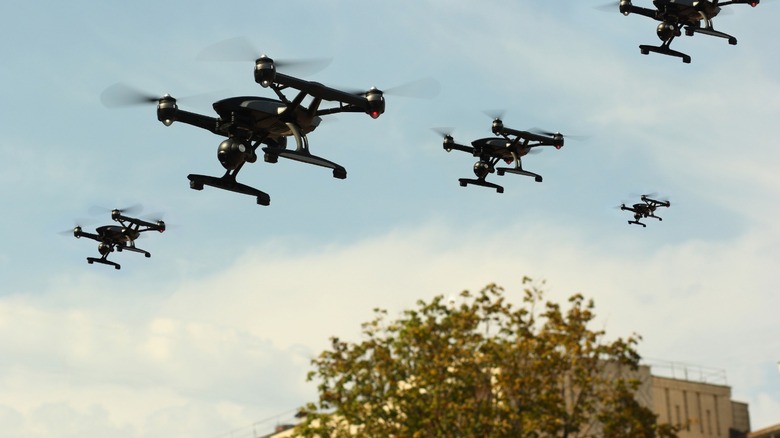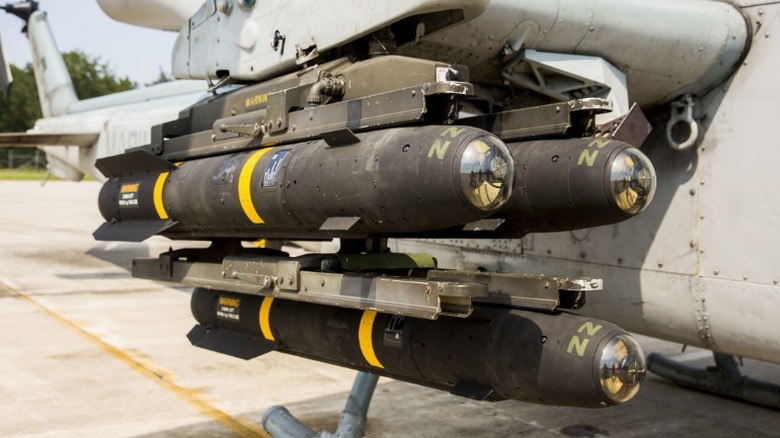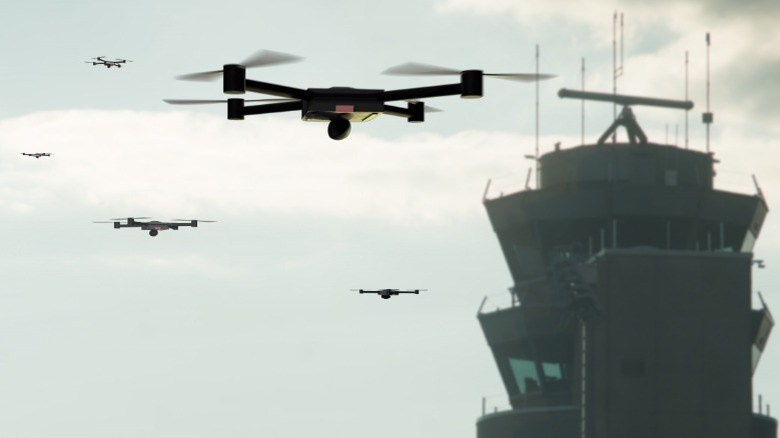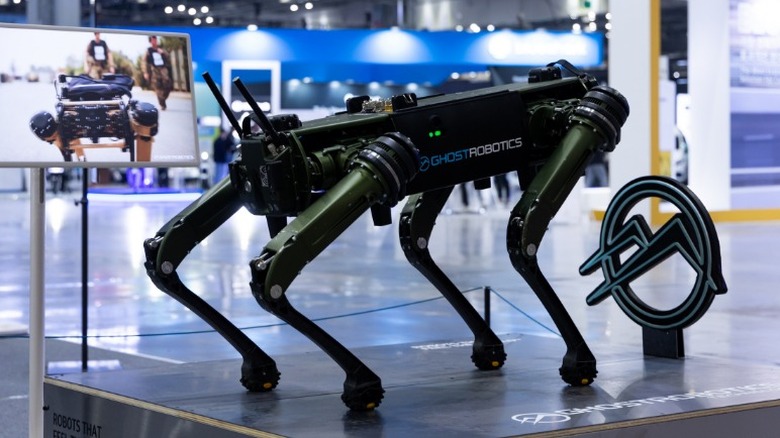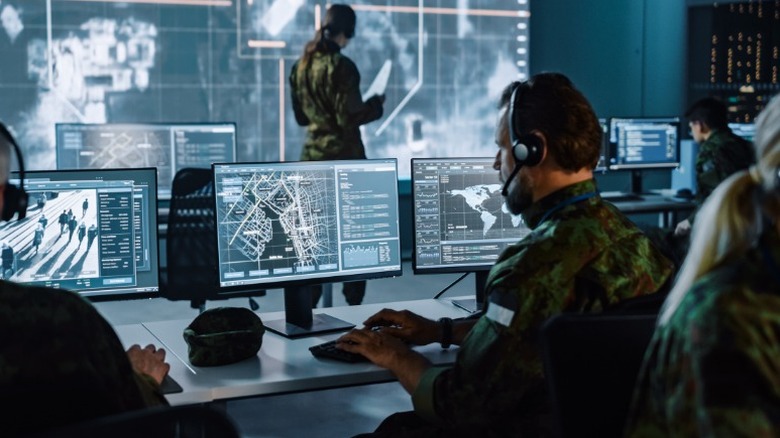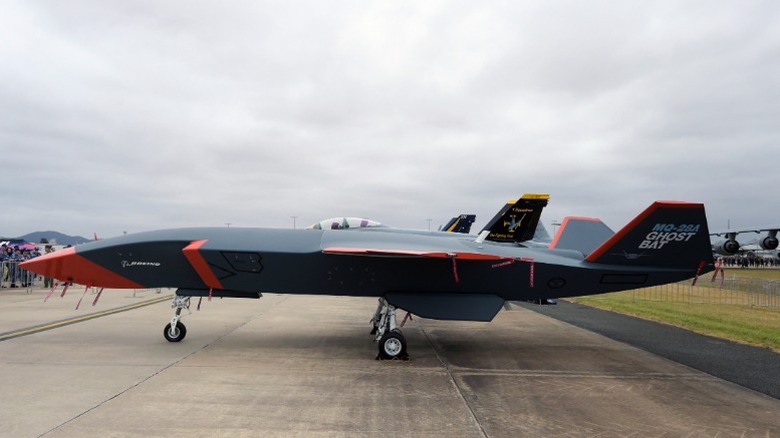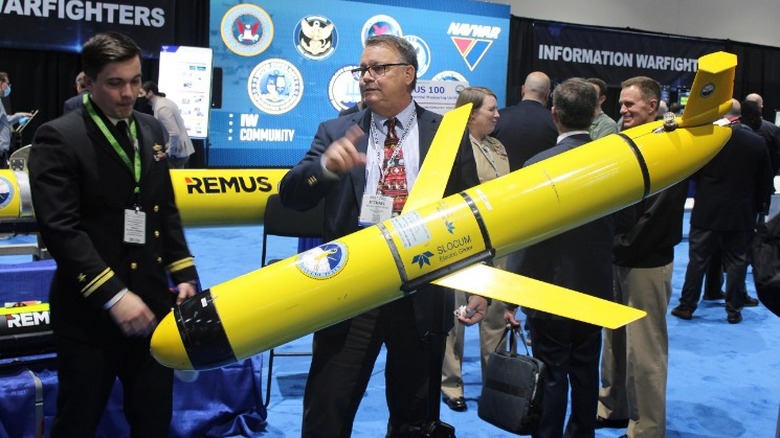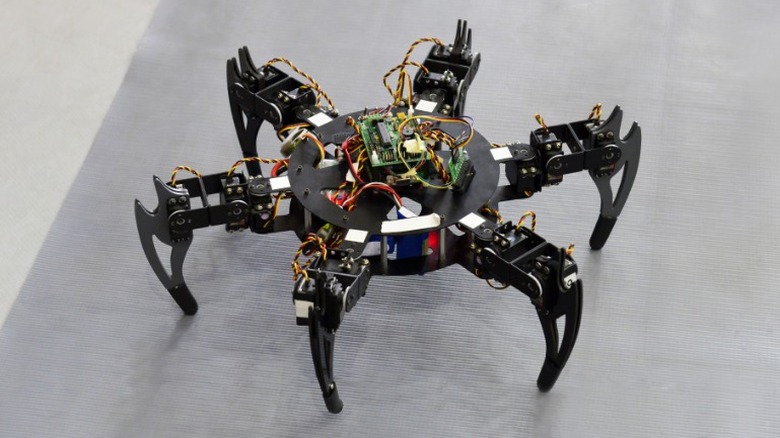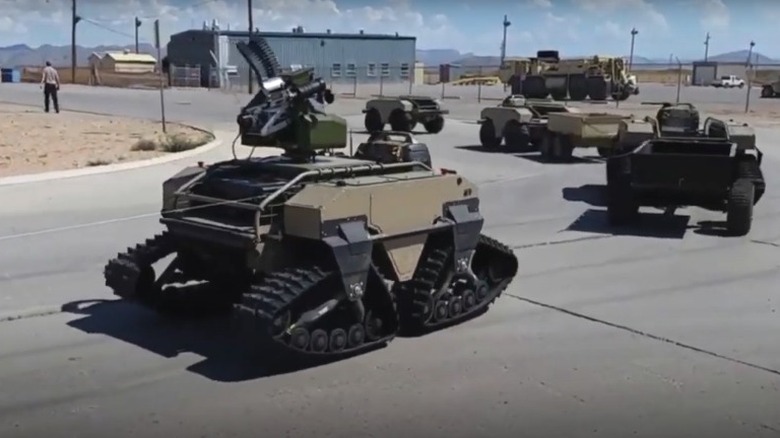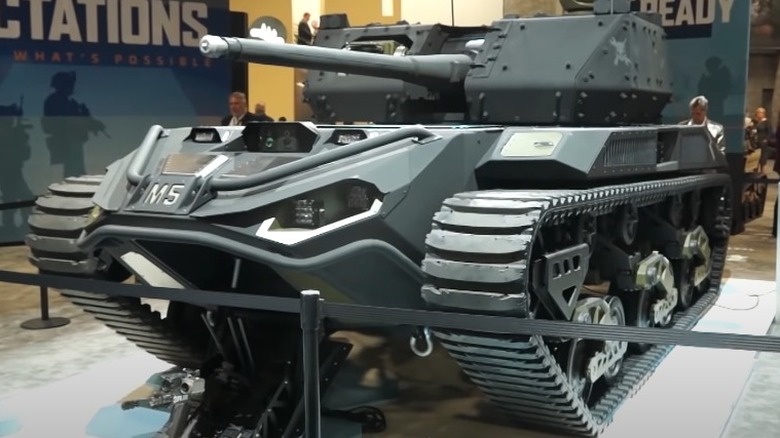11 Scariest Military Applications Of AI
Artificial intelligence (AI), machine programming meant to simulate human intelligence processes, is a new and promising technology that seems poised to upend our lives in myriad ways, many (or most) of which we do not yet know. With such a rapid development of something with the potential of wielding great power, results can be unpredictable as it is disseminated throughout the public, allowing users and researchers to discover novel applications of AI in broad areas of implementation. Industries as diverse as education, medicine, communication, and engineering are already seeing the effects of AI integration into the workplace.
But one tenet of modern society, that could be seen as an irrefutable maxim, is that any new technology that can be harnessed and adapted for military uses will be. The U.S. Military is a hotbed of technological innovation and it always has been, and AI is already well embedded within the Pentagon.
While we discover how our soldiers will best protect the populace, we must acknowledge the potential dangers of AI when applied to systems and devices of lethality. Having machine assistance to make tactical decisions is something we have had throughout the last century of mechanized war, but handing over decisions to use deadly force to a computer program alone removes some human accountability, and the ability to make nuanced and ethical decisions on when to use force. In chess, a player's error can lead to a lost game. In the military, an error can lead to death and destruction. These are 11 of the scariest military applications of AI.
Autonomous firearms
Already deployed in Israel to cover the boundaries of the West Bank and Gaza, these autonomous weapons are programmed to track and fire at targets on their own, which could lead to devastating results for civilians. The idea of firearms that are capable of firing on a target without an exact and specific command from a human user is at least somewhat terrifying or, at least, potentially so. And while it sounds like something to be found in video games or a future world sci-fi movie, this already exists, and the tech has been implemented by the Israeli government.
To say this weapon will fire without human input is, admittedly, hyperbole, but it is not far from the truth. In the West Bank, Israeli settlements intertwine and encircle Palestinian territory far more than most Westerners are likely aware of. The map of the West Bank is a spider web of protected neighborhoods with Israel Defense Forces (IDF) set up on perimeters and in checkpoints, ostensibly to keep the peace. In control towers sit soldiers who monitor activity outside the walls for potential threats, and, when a target is detected, a soldier can initiate a command to the gun turrets about an identified target — and the guns take over from there. They are said to be equipped with tear gas, rubber bullets, and stun grenades, used to prevent volatile situations from arising. But the potential to use live ammunition in these is grave, and, in the wrong hands, could easily lead to atrocities.
AI-guided missiles
The guided missile has been a weapon in the arsenal of modern militaries for decades now. Early models used optics for tracking, followed later by infrared and then laser, but all of these required specific inputs for it to successfully reach its target. The next generation of guided missiles will be able to course correct on their own, using algorithms designed to react to changing conditions on the battlefield.
Already under development by the U.S. Department of Defense (DOD), these next generation of guided missiles will have the capability to independently track targets after launch using optical imaging, infrared, radar, and other technologies, using AI to maintain a fix on the target and adjust its course. These are long-range weapons that can be fired up to 200 miles from a target and achieve near-perfect accuracy. Furthermore, datalinks can enable multiple weapons to work together, with shared information to update targeting information throughout the flight path.
While more precise targeting can be seen as a way of ensuring strikes of strictly military targets can reduce possible civilian casualties, the technology is advancing at a fever pitch. There remains cause for concern that this tech does not make it into the wrong hands.
Drone swarms
Many of us have already had the opportunity to experience the wonder of a drone light show, where flocks of drones fly around in the night sky assembling to create illuminated images in the sky. This dazzling entertainment is made possible by drone technology and AI, but the same basic elements that make a light show possible can be applied to weapons systems to devastating effect.
The Pentagon already has a name for this, Autonomous Multi-Domain Adaptive Swarms-of-Swarms (AMASS). The goal is to develop the capability to have a swarm of drones launched from land, sea, and air — all interconnected and autonomous — with the result of swarming an enemy and dominating their positions with overwhelming force. The U.S. Department of Defense is working fervently on this project, pouring billions into research and development. Among other nations, it is also known that China in particular is throwing billions at military AI research, creating a modern arms race based on high technology.
One drone swarm has already been deployed by Israel. In 2021, the IDF sent a fully autonomous swarm of drones to locate and attack Hamas, along with other conventional weapons. While the U.S. Department of Defense has safeguards in place to keep certain ethical principles in place regarding AI, when the tech matures and spreads to other nations, these protections may become insufficient.
Robot soldiers
The ideas of soldiers on the battlefield facing exacting and merciless machines, like the Cyon Centurians of Battlestar Galactica or the droid armies of Star Wars, seem like flights of fancy from the world of science fiction, but life may be on the verge of imitating art, as it so often does. The Department of Defense is investing heavily in cutting-edge weapons that use AI and other autonomous technologies to augment personnel in forces on land, sea, and air.
While the actual machines are unlikely to be bipedal humanoids, their autonomous nature and full armaments are likely to be seen in forms with wheels, tracks, and even limbs. While Boston Dynamics has signed a pledge against developing its robots into military equipment, others have not. Ghost Robotics is developing quadrupedal dog-like robots, where the use of legs for mobility allows these machines to traverse most surfaces and grades, going places where tracks or wheels could get stuck. They can be used like automated assistants, using AI to keep up with a unit on deployment, staying with troops autonomously by wireless tether. They can also be used for scouting, mine clearing, or remote firing of weapons, keeping personnel out of the line of fire.
The possible applications for such equipment are boundless but also bring an ethical minefield. Setting boundaries for how these will be deployed in ways that will gain international accord will likely make clearing this minefield harder than a traditional one. Regardless, don't expect to see droids lining up against each other on the battlefield just yet.
AI intelligence gathering
A good commanding officer knows they are only as good as the information they have to act on. For eons, gathering intelligence has been a critical part of any successful military campaign, and it has become exponentially more sophisticated over the last three decades. Although we are well into the digital age, the integration of AI into intelligence-gathering technologies is about to raise that sophistication to levels unfathomable a decade or so ago.
There will never be a substitute for having eyes on an adversary, but the digital world we all operate in provides avenues for gathering other kinds of intelligence. The U.S. Army Cyber Command, founded in 2010, supports the Army in many ways, including digital surveillance. Applied to military intelligence, AI speeds up the collection and analysis of data by orders of magnitude. The Air Force wants it to be integrated into all of its future intelligence technology. Not only can it pore over vast amounts of data, but it can also be trained to parse out specific information and process it into actionable information autonomously. It also knocks down language barriers, and can be used to identify individual voices and faces in ways not possible in the past. And this burgeoning field is just getting started.
Setting loose autonomous AI intelligence gathering on society creates the danger of an information-capturing dragnet targeting ordinary citizens. The risk of infringing on constitutional rights is high as this technology develops, with many encouraging the government to keep a close eye on the Department of Defense, to prevent civil liberties from being compromised in the name of security.
Autonomous aerial drones
In a project forming part of an Australian defense initiative, Boeing is developing and building what has become known as the MQ-28 Ghost Bat, and the U.S. Air Force has expressed considerable interest in the project. This new aircraft is more than just the latest drone technology, and with the addition of AI is much different from existing platforms, such as the Predator. The Ghost Bat is an AI-piloted "loyal wingman," meant to fly alongside fighter jets and aid pilots on missions by adding to the surveillance capabilities and firepower already available to them.
The Ghost Bat has a range of 2,300 miles with an endurance time of 16 hours, and can reach near supersonic speeds thanks to its Pratt and Whitney PW 600 turbofan engine. Unlike other drones operated from command centers on the ground, this would be controlled by an accompanying plane with certain AI-powered systems to allow it to perform mission functions autonomously. It would have functions to enable it to tail its host aircraft without a pilot giving it specific flying control inputs, and also has automatic take-off and landing capabilities.
The Ghost Bat is not yet in service with any air force, but testing is ongoing, and it is likely to be certified soon. This technology does not present many ethical dilemmas or threats for ordinary civilians, but for opposing forces, it should be a terrifying foe, multiplying incoming threats with an aerial asset not afraid of death.
Autonomous submarines
In official parlance, a submarine drone is known as an Unmanned Underwater Vehicle (UUV), and the development of this type of craft is well underway. The U.S. Navy and others are already implementing UUVs that are controlled remotely from command stations situated on land or sea. Ukraine has its own indigenous craft that successfully executed missions against Russian naval forces during the Russian-Ukraine conflict in 2022. But future deployments of UUVs will have additional degrees of autonomy, thanks to the incorporation of AI in their guidance and targeting systems.
The U.S. Navy is working to expand its fleets of UUVs, with an increasing number guided by AI. One area of particular interest is deployment in the waters of the Caribbean and around South America in drug smuggling interdiction missions, as well as efforts to thwart human trafficking. AI can help a UUV to detect and track suspicious vessels, and alert personnel on surface water ships in real time of the whereabouts of a potential threat.
The Royal Navy of the U.K. has already begun work on the largest UUV planned to date. It should be able to operate up to 3,000 miles from its home port for periods of up to three months. But the real lead of the story is that its navigation and actions will be guided entirely by AI, enabling it to operate with total radio silence while deployed. The is that safeguards are in place to prevent a rogue AI from wreaking havoc in the seas.
Robotic insects
Scientists and engineers have for centuries looked to nature to figure out how to apply concepts in mechanical design to create new technologies. The world of insects provides ample inspiration for modern creations, including miniature-flying drones. These are perfect for covert surveillance, as craft built small enough can move into hostile territory almost entirely undetected. Furthermore, when applied en mass, knocking them out can prove extremely difficult.
Insect military robots are already well on the way to becoming a reality. British Special Forces already have the WASP, a micro-sized 6-inch aircraft used for reconnaissance in Afghanistan. Although it is remote-operated, the integration of AI is the next step in its development. Research in this area is ongoing and attempting to overcome some hurdles. Processing, memory storage, and continued powering of devices are all severely limited by the small size of these devices, but these problems are not insurmountable with more research and testing.
The U.S. Department of Defense has awarded contracts through DARPA for developing insect-inspired and scaled robots, primarily for search and rescue missions or for performing inspections in environments hazardous to humans. However, as with so many civilian technologies of the past, it may only be a matter of time before more tactical applications will be developed, without any treaties or ethical guidelines to limit the destructive nature of new micro weapons systems.
Robot mules
Some of the more realistic upcoming applications of AI and robotics are machines that can assist soldiers in carrying equipment and supplies into battle. Modern soldiers carry around 27 pounds of personal protection before adding any weapons, ammunition, and rations. With all equipment and supply in tow, a soldier can have up to 140 pounds of weight to carry. This increases fatigue, reduces mobility, and introduces more possibilities for injuries.
New and developing technology to create autonomous robotic pack mules is emerging that can help a combat force to be more agile and with less fatigue. To relieve soldiers' burden, DARPA developed the Legged Squad Support System (LS3). It is a robotic pack mule that was developed beginning in 2012. However, after much testing, it was determined that it would be too loud for practical use. However, today there is the Multi-Utility Tactical Transport (MUTT), an 8-wheeled electric uncrewed ground vehicle capable of carrying heavy supplies to places where a truck cannot go. It can be operated remotely or semi-autonomously using GPS and inertial navigation system signals. It is also available in a tracked version and can operate in water.
These are the least fearsome of the upcoming generation of AI-powered military technology. However, as they augment tactical groups on the ground, they provide a distinct advantage over an adversary forced to carry supplies on their back.
Amphibious surveillance robot
In another situation where life imitates art comes the GuardBot. Resembling the Star Wars droid BB-8, GuardBot is an autonomous rolling ball able to provide covert surveillance on land and in water.
This is considered an Unmanned Ground Vehicle (UAV) and is developed jointly by Aquiline Drones and Guardbot. The makeup of GuardBot is highly unusual but gives it robust capabilities: It is a rolling ball equipped with cameras that can offer 360-degree views as it traverses land and water. It can come in a range of sizes from just 6.5 inches to 7 feet in diameter, with an internal mechanism that allows it to drive forward and backward as well as have a free range of turning. The pods on either side house interchangeable equipment such as video cameras, infrared, thermal, microphones, and audio equipment. It can operate for up to 25 hours on a single charge, moving to 12 mph on land and 3 mph in water, and Its unique shape makes it possible to overcome a wide range of obstacles and climb steep slopes. The single-contact patch offers low rolling resistance, which lowers power usage.
This can also be programmed with AI to be a roving sentinel within a geofenced area, providing users with remote capabilities of surveilling an adversary with minimal chance of detection. Testing with the U.S. Marine Corps began in 2014. Information of any official deployment is scarce, but the company is still around, and this could be aiding troops somewhere right now.
Ground combat vehicles
Beginning in 2021, the U.S. Army is testing the next generation of uncrewed combat vehicles guided by AI. Final announcements as to which projects will be awarded are still pending, and the range of potential systems is currently varied. Some of the ideas being explored include small and agile tracked vehicles with heavy armament that can be operated remotely or with semi-autonomous capabilities, as well as full-size strike vehicles that can be used with or without an operator. AI can be applied not only to propulsion and navigation, but also to targeting and surveillance systems relaying real-time conditions on a battlefield, while keeping personnel at a safe distance.
When these projects finally come to fruition, a scenario can be envisioned where battles are fought between remotely operated equipment, with live platoons waiting to take territory or advance frontlines with reduced risk. However, in any matchup of unequal adversaries, those who possess these advanced fighting systems will gain a significant upper hand. While this could reduce casualties in battle, it could also spur a new arms race built upon technology and AI, for better or worse.
